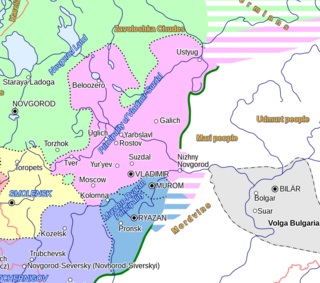
Vladimir-Suzdal, formally known as the Principality of Vladimir-Suzdal or Grand Principality of Vladimir (1157–1331), also as Suzdalia or Vladimir-Suzdalian Rus', was one of the major principalities emerging from Kievan Rus' in the late 12th century, centered in Vladimir-on-Klyazma. With time the principality grew into a grand principality divided into several smaller principalities. After being conquered by the Mongol Empire, the principality became a self-governed state headed by its own nobility. A governorship of the principality, however, was prescribed by a jarlig issued from the Golden Horde to a Rurikid sovereign.

Iziaslav Yaroslavich was Prince of Turov and Grand Prince of Kiev.
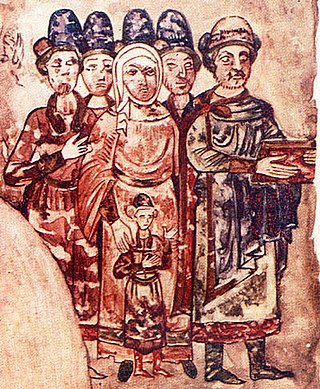
Sviatoslav II Iaroslavich or Sviatoslav II Yaroslavich was Grand Prince of Kiev from 1073 until his death in 1076. He was a younger son of Yaroslav the Wise, the grand prince of Kiev. He is the progenitor of the Sviatoslavichi branch of Rurikids.
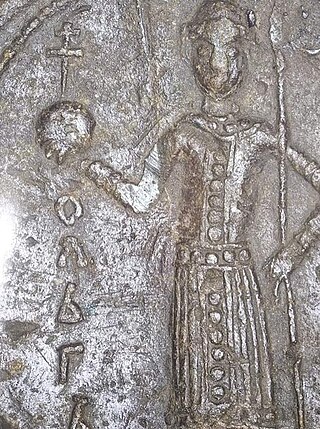
Oleg Svyatoslavich was a prince from Kievan Rus' whose equivocal adventures ignited political unrest in the country at the turn of the 11th and 12th centuries. He reigned as Prince of Chernigov from 1097 to 1115, and was the progenitor of the Olgovichi family.
Severia or Siveria is a historical region in present-day southwest Russia, northern Ukraine, and eastern Belarus. The largest part lies in modern Russia, while the central part of the region is the city of Chernihiv in Ukraine.

Mstislav Mstislavich the Daring, also called the Able, was a prince of Tmutarakan and Chernigov, one of the princes from Kievan Rus' in the decades preceding the Mongol invasions.
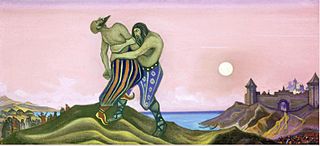
Mstislav Vladimirovich was the earliest attested prince of Tmutarakan and Chernigov in Kievan Rus'. He was a younger son of Vladimir the Great, the grand prince of Kiev. His father appointed him to rule Tmutarakan, an important fortress by the Strait of Kerch, in or after 988.
The Prince of Chernigov was the kniaz, the ruler or sub-ruler, of the Rus' Principality of Chernigov, a lordship which lasted four centuries straddling what are now parts of Ukraine, Belarus and the Russian Federation.
The Prince of Murom was the title of the ruler of the Principality of Murom.

The Principality of Murom, also referred to as the Murom-Ryazan Principality until the mid-12th century, was a principality with its capital in Murom, now in Vladimir Oblast, Russia. Murom lay in an area that was strongly Finnic and for much of its medieval history, located in the homeland of the Muromians. In 1392, it was incorporated into the Grand Principality of Moscow.
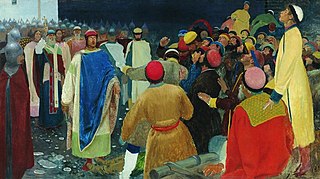
Gleb Svyatoslavich was Prince of Tmutarakan and Novgorod of Kievan Rus'. He ruled Tmutarakan under the overall authority of his father Sviatoslav Iaroslavich, Prince of Chernigov. He was twice expelled from his principality by one of his cousins Rostislav Vladimirovich.

The Council of Liubech was one of the best documented princely meetings in Kievan Rus' that took place in Liubech on October 19, 1097. The council ended the Chernihiv war of succession (1093–1097) between Sviatopolk II of Kiev, Vladimir II Monomakh and Oleg I of Chernigov who fought for the heritage of his father Sviatoslav II of Kiev.

The Rurik dynasty, also known as the Rurikid or Riurikid dynasty, as well as simply Rurikids or Riurikids, was a noble lineage allegedly founded by the Varangian prince Rurik, who, according to tradition, established himself at Novgorod in the year 862. The Rurikids were the ruling dynasty of Kievan Rus' and its principalities following its disintegration.
Mstislav II Svyatoslavich was a Kievan Rus' prince. His baptismal name was Panteleymon. He was probably prince of Kozelsk (1194–1223), of Novgorod-Seversk (1206–1219), and of Chernigov (1215/1220–1223). He was killed in the Battle of the Kalka River.
Oleg III Svyatoslavich was a Kievan Rus' prince. His baptismal name was Feodosy. He was prince of Vshchizh, of Novgorod-Seversk (1200–1201), and of Chernigov (1201/1202–1204).
Yaroslav II Vsevolodovich was an Olgovichi prince. He was prince of Ropesk, of Starodub (1166–1176), and of Chernigov (1176–1198).
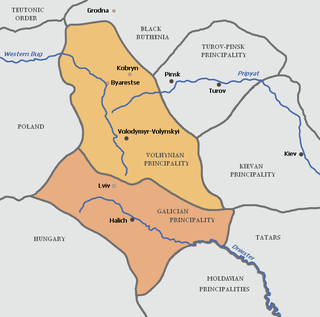
The Principality of Volhynia was a western Kievan Rus' principality founded by the Rurikid prince Vsevolod in 987 centered in the region of Volhynia, straddling the borders of modern-day Ukraine, Belarus, and Poland. From 1069 to 1118, it belonged to Izyaslavichi who primarily ruled from Turov. After losing Turov to Monomakhovichi in 1105, the descendants of Iziaslav Yaroslavovich for a few years continued to rule in Volhynia. From 1154 to 1199, the Principality was referred to as the Principality of Volodymyr when the Principality of Lutsk (1154–1228) was separated.
Roman Svyatoslavich or Roman the Handsome was prince of Tmutarakan in Kievan Rus'. The starting year of his reign is uncertain, but he reigned his principality from around 1073 or 1077. His former allies, the Cumans killed him after their unsuccessful joint campaign against his uncle, Vsevolod I of Kiev.
The Mongol siege, capture and sack of Chernigov, capital of the Chernigov Principality, occurred on 18 October 1239 during the westward expansion of the Mongol Empire. It was part of the 1237–1242 Mongol invasion of Kievan Rus'.













